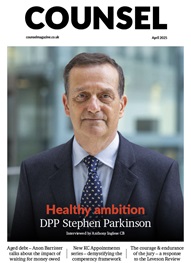*/
Nine out of ten Silks are men and it will take 50 years to achieve gender equality, according to the latest figures from the regulator.
Women account for 36.5% of the practising Bar, up by 0.6% since 2015, and only 13.7% of QCs, according to the annual Report on Diversity at the Bar from the Bar Standards Board (BSB).
The figures showed there continues to be a disparity between the total percentage of black and minority ethnic (BAME) barristers across the profession (12.2%), and the percentage of BAME QCs (6.4%).
While there remains an over-representation of barristers from fee-paying schools: 10.7% of the profession compared to 7% of the population.
At the current rates of change, the report said it would take over 50 years for women to make up 50% of QCs, and nearly twice as long for BAME barristers to make up 16% of QCs, drawing them in line with the wider population of England and Wales.
The BSB said there continued to be a low response rate to diversity data, with the majority of questions answered by approximately one-third of the profession.
Bar Chairman, Andrew Langdon QC, said: ‘One of the key challenges is to get women to stay in the profession for longer, widening the pool of talented women available so that more can apply for Silk and judicial appointment.
‘We also need to increase the number of BAME barristers who become QCs and go to the bench, and to enable more state school students to join the profession. If we succeed, we will have a legal profession and judiciary that reflect the communities they serve.’
Nine out of ten Silks are men and it will take 50 years to achieve gender equality, according to the latest figures from the regulator.
Women account for 36.5% of the practising Bar, up by 0.6% since 2015, and only 13.7% of QCs, according to the annual Report on Diversity at the Bar from the Bar Standards Board (BSB).
The figures showed there continues to be a disparity between the total percentage of black and minority ethnic (BAME) barristers across the profession (12.2%), and the percentage of BAME QCs (6.4%).
While there remains an over-representation of barristers from fee-paying schools: 10.7% of the profession compared to 7% of the population.
At the current rates of change, the report said it would take over 50 years for women to make up 50% of QCs, and nearly twice as long for BAME barristers to make up 16% of QCs, drawing them in line with the wider population of England and Wales.
The BSB said there continued to be a low response rate to diversity data, with the majority of questions answered by approximately one-third of the profession.
Bar Chairman, Andrew Langdon QC, said: ‘One of the key challenges is to get women to stay in the profession for longer, widening the pool of talented women available so that more can apply for Silk and judicial appointment.
‘We also need to increase the number of BAME barristers who become QCs and go to the bench, and to enable more state school students to join the profession. If we succeed, we will have a legal profession and judiciary that reflect the communities they serve.’


Now is the time to tackle inappropriate behaviour at the Bar as well as extend our reach and collaboration with organisations and individuals at home and abroad
A comparison – Dan Monaghan, Head of DWF Chambers, invites two viewpoints
And if not, why not? asks Louise Crush of Westgate Wealth Management
Marie Law, Head of Toxicology at AlphaBiolabs, discusses the many benefits of oral fluid drug testing for child welfare and protection matters
To mark International Women’s Day, Louise Crush of Westgate Wealth Management looks at how financial planning can help bridge the gap
Casey Randall of AlphaBiolabs answers some of the most common questions regarding relationship DNA testing for court
Maria Scotland and Niamh Wilkie report from the Bar Council’s 2024 visit to the United Arab Emirates exploring practice development opportunities for the England and Wales family Bar
Marking Neurodiversity Week 2025, an anonymous barrister shares the revelations and emotions from a mid-career diagnosis with a view to encouraging others to find out more
David Wurtzel analyses the outcome of the 2024 silk competition and how it compares with previous years, revealing some striking trends and home truths for the profession
Save for some high-flyers and those who can become commercial arbitrators, it is generally a question of all or nothing but that does not mean moving from hero to zero, says Andrew Hillier